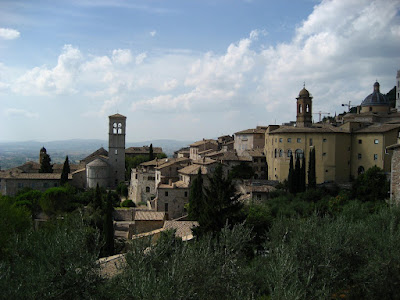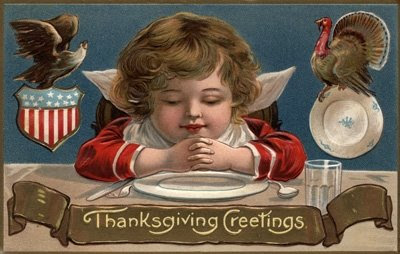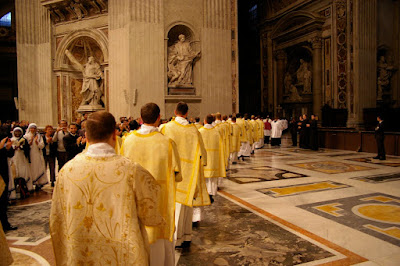
Well, the retreat is over -- long over, in fact. Although we observed silence there, I didn't mean for my silence here to carry on for quite so long. Thanks for the thoughts and prayers you passed along while I was
in ritiro; it was a great week and certainly much needed after all of the transitions of the first few months here. The hectic schedule quickly returned, but before filling you in all of the events of the past week, I wanted to finally detail some recent trips I was able to take in the footsteps of St. Francis.
 Assisi
AssisiAs I'm sure you know, Assisi is the birthplace of Francis, the son of a wealthy cloth merchant who decided to reject the opulent life of the medieval upper class and instead live as a beggar. The
friars minor that began following him soon became one of the world's largest religious orders (eventually several orders, in fact) and today the Franciscans remain perhaps Italy's most influential order. Certainly the devotion to Francis and to all things Franciscan is very high here (he's the patron saint of the country), especially in the region of Umbria where Francis spent most of his life. I was excited for the chance to visit Assisi, having heard of the medieval character and appearance that it still retains and knowing of the importance this small town had on the universal Church.
Originally a Roman settlement on the slopes of
Mount Subasio, Assisi was an important medieval trade center as well as a later
Ghibelline stronghold. It was in one of the battles against Guelphs from the nearby town of Perugia that Francis di Bernardone was taken captive and held for a year. Francis was never close to his father -- he was born around 1182, probably while his father was away on a business trip to France, his mother's native land. Tradition has it that his mother originally named John after the Baptist, in the hopes that he would be a religious figure of importance for Italy. His father, however, had no such aspirations for him (he was a Ghibelline himself) and as such renamed him
Francesco, likely due to his infatuation with the hip culture of France.

Francis grew up wanting for little and was known as a lively and gregarious youth, yet he also displayed a distinctively charitable character at a young age, feeling compassion for the lepers of the city and showing charity to its beggars. After Francis' imprisonment in Perugia in 1205, he returned to Assisi but soon found himself disillusioned with his former life of excess and entered a period of soul-searching. His concern and care for the sick and the poor grew, and he retired to nature often to escape the pressures and the emptiness he found in merchant class society. He continued to work in his father's trade but the two often clashed as Francis did not display the work ethic and commitment to profit which his father possessed.
 The path down the mountain to San Damiano
The path down the mountain to San Damiano
Around 1207, Francis was praying in the dilapidated church of San Damiano on the outskirts of Assisi when the
cross displayed there spoke to him, "Francis, rebuild my church which as you see is falling in to ruin." Energized by this personal call, Francis used his personal funds to begin reconstructing San Damiano and several other dilapidated churches in the area. As his money begin to run out, however, Francis decided to sell precious cloth and other valuable items owned by his father to pay for the repairs. This, it seems, was the proverbial last straw with Francis' old man, who dragged Francis to an audience with the local bishop where he publicly accused him of insubordination, filial disobedience, and theft. Francis, realizing both his error and the brokenness of his relationship with his father, gave up his rights as heir to his father and gave him back on the spot all of his possessions, including, reportedly, his clothes. Soon after, while attending Mass, Francis prayed that he might be given to direction in his life and took as his answer the Gospel proclaimed that day, Matthew 10:6-10, in which Christ sends the Apostles out to preach without making provisions for the journey. Francis realized that he had misinterpreted the call he had heard in San Damiano: he was not to undertake a rebuilding campaign for church buildings but rather was called to renew the life of the Church as a whole.
 The Porziuncola chapel where Francis died, at the foot of Mount Subasio
The Porziuncola chapel where Francis died, at the foot of Mount Subasio
New orders, especially those espousing poverty and penitence, were not uncommon at the time (the
Waldensians, for example, started similarly before becoming heretics), and many Church authorities saw them as a danger to the establishment and tradition of the Church itself. Francis worked quickly to outline a
framework for his order and to attain approval for it from Rome. Soon, other orders started in imitation of the Friars Minor, most notably the Order of Poor Ladies, founded by Clare, a friend of Francis' and fellow resident of Assisi. Continuing to teach and lead the men who followed him, Francis also became involved in efforts to evangelize to the Muslims in the Holy Land in hopes of ending the violence there. He died in October 1226 at the age of 45. Even in death seeking to follow Christ, Francis was buried at his request on the "Hill of Hell" below the town, where criminals were executed and buried. He was canonized in Assisi less than two years later by Pope Gregory IX.
 The Basilica of San Francesco in Assisi
The Basilica of San Francesco in Assisi
The
Basilica of San Francis, the cornerstone of which was laid by the same pope at the site of the saint's tomb, is an amazing and unique structure which I thoroughly enjoyed visiting. The architecture tends to blend various stylistic elements, most notably late Italian Romanesque and early Gothic, but it is the frescoes adorning the inner walls that are most impressive. The newer, upper basilica features a series of frescoes by
Giotto of Francis' life, while the lower basilica parallels various events in Francis' life with the life of Christ, in frescoes by Giotto and Lorenzetti. Both were quite lovely, but I particularly enjoyed the dramatic beauty of the lower basilica. (In fact, I even purchased a print of Lorenzetti's "
Madonna of the Sunset," named so because the afternoon sun shines on the fresco.) Assisi has a lot of great sights, including the Basilica of St. Clare, the Church of San Damiano, and more, but certainly the famous Basilica of Saint Francis is the jewel of the city.
 The Hermitage of Prisons on Mount Subasio
The Hermitage of Prisons on Mount Subasio
On visiting Assisi, our group took a trip 4 km up Mount Subasio to the Hermitage of the Prisons, so named after a Benedictine hermitage on the site was given to the Franciscans who wanted to be "prisoners" of contemplation and prayer. Francis himself visited the site several times and built a grotto in the woods nearby; tradition has it that it was at this grotto that he gave his famous
sermon to the birds. We were able to have Mass at this grotto and spend some time in prayer and reflection. As one who has always enjoyed nature, and found in it a medium for communing with God, it was moving for me to be where Francis himself had once prayed.

Our class was able to grow even closer to the Franciscan tradition in central Italy during our retreat in Greccio at a retreat center run by Franciscans. Greccio, about 100 km south of Assisi near Rieti, is a quiet mountain town in the Central Apennines, weather and country that felt very similar to Colorado. It was, in short, a great place for a retreat. As I mentioned before, it was in Greccio in 1223 that Francis decided to provide a new way of celebrating Christmas by reconstructing the nativity scene, known in Italy as a
presepe, in a cave on Mount Sabini. From this original
presepe, the worldwide tradition of the Christmas crib began.
 The Sanctuary of Saint Francis in Greccio
The Sanctuary of Saint Francis in Greccio
Our retreat center was only a few minutes walk from the sanctuary and friary that developed around the cave, and I was able to spend several hours during the week praying in the chapel there and in the area. The views of the Rieti valley below were breathtaking and wandering around in the medieval chapel and the cells of the Franciscan sanctuary added a kind of timeless and mystical experience to the whole week. The sanctuary also had an extensive collection of various
presepi, models of nativity scenes from around the world, each with their own unique cultural flair. It was interesting to see how this one event of Christ's birth affected and was adapted to each particular culture.

All of these somewhat disjointed experiences left me nonetheless with a new appreciation for the great figure of Francis and the imprint he left on both Italian and Catholic life. Too often he's mistaken as a kind of half-crazed hippie who challenged authority when instead he was much closer to the spirit of our Lord himself, preaching repentance, simple reliance on God, and a deep love for the poor. Through his faith and commitment, he and his friars did help to renew the Church in the Middle Ages and set the stage for greater renewal as well.
 The Rieti valley, from the sanctuary on Mount Sabini in Greccio
The Rieti valley, from the sanctuary on Mount Sabini in Greccio
Last week, the Fourth Year men here at the NAC were ordained to the
transitional diaconate in St. Peter's Basilica, a ministry dedicated to preaching the Gospel and ministering to the poor and oppressed. The post on this is to come, but it was truly a great event, an uplifting witness of what the Lord can accomplish in those that respond to his call. On Friday, one of the new deacons for Little Rock journeyed to Assisi, with the pilgrims that had come for his ordination in tow, to celebrate his first Mass as a deacon in the Basilica of St. Francis. As I returned to the lower basilica which details the lives of Jesus and Francis, the one which I had enjoyed so much on my first visit, I reflected on how fitting it was that this place would be chosen for this man's Mass of Thanksgiving.

Francis, despite being one of the great saints and reformers of the Church, was himself not a priest but a deacon. Indeed, he very much embodied heart and soul the role of the deacon in the Church. Now, nearly 800 years later, a man from Arkansas will, at least for the next several months, serve the same Church in the same way. It was beautiful to witness the symbolism present as we celebrated his first Mass as a deacon: one man beginning his diaconate ministry in the basilica dedicated to another who had performed the same ministry so well. How wonderful it is that, even today, the witness of Francis and the tradition remains vibrantly alive in the Church today, present in new and ever more compelling ways.
 A Nativity scene from the central panel of the Middelburg Altarpiece by Rogier van der Weyden, a medieval Flemish painter
A Nativity scene from the central panel of the Middelburg Altarpiece by Rogier van der Weyden, a medieval Flemish painter









































